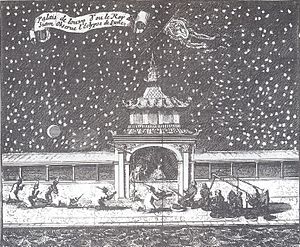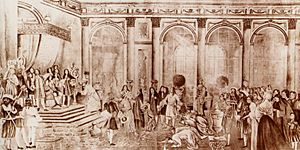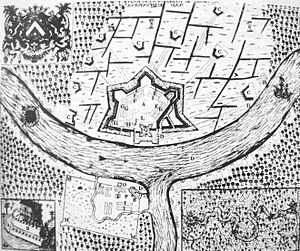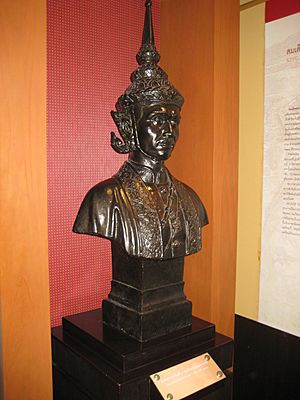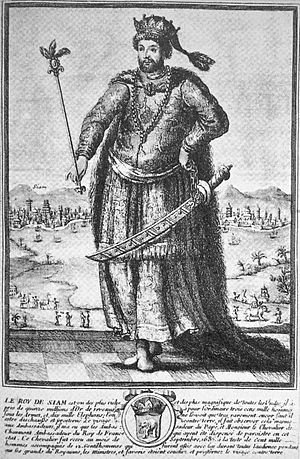Narai facts for kids
Quick facts for kids Narai the Greatนารายณ์มหาราช |
|
|---|---|
| King of Ayutthaya | |
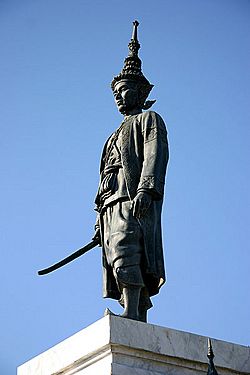
Statue of Narai the Great, created in 1966, near Lopburi provincial hall
|
|
| King of Ayutthaya | |
| Reign | 26 October 1656 – 10/11 July 1688 |
| Predecessor | Si Suthammaracha |
| Successor | Phetracha |
| Born | 16 February 1632 |
| Died | 10/11 July 1688 (aged 56) |
| Consort | Kasattri |
| Issue | Sudawadi, Princess Yothathep |
| House | Prasat Thong dynasty |
| Father | Prasat Thong |
| Mother | Sirithida |
King Narai the Great (Thai: สมเด็จพระนารายณ์มหาราช, RTGS: Somdet Phra Narai Maharat) was the 27th ruler of the Ayutthaya Kingdom in Thailand. He was the fourth and last king of the Prasat Thong dynasty. King Narai ruled from 1656 to 1688. Many people consider him one of the most famous kings of his dynasty.
His time as king was very successful for Ayutthaya. There was a lot of trade and diplomacy with countries far away, including those in the Middle East and Europe. During his later years, Narai gave a lot of power to a Greek adventurer named Constantine Phaulkon. Phaulkon became like a prime minister. He helped Ayutthaya form close ties with the French king, Louis XIV. French soldiers and missionaries came to Ayutthaya. This led to some problems between the French and local officials. It eventually caused a big change in power near the end of Narai's rule in 1688.
King Narai's reign is also known for a war with Burma (1662–1664). He also dealt with conflicts involving the English East India Company. Many foreign visitors, like French Jesuits and Persian diplomats, wrote about Ayutthaya during this time. These writings give us a lot of information about the city and its royal court in the 1600s. This is important because the capital city was completely destroyed in 1767.
Contents
Early Life and Becoming King
Prince Narai was born on February 16, 1632. His father was King Prasat Thong, and his mother was Princess Sirithida. King Prasat Thong had become king in 1629. Narai had a younger sister, Princess Si Suphan, and an older half-brother, Prince Chai. He also had an uncle, Prince Si Suthammaracha.
An old royal book says that when Narai was born, he briefly appeared to have four arms. This was seen as a miracle. So, his father named him Narai, after the Hindu god Vishnu, who is often shown with four arms.
When King Prasat Thong died in 1656, Prince Chai became King Sanpet VI. However, in Thai tradition, brothers often had a stronger claim to the throne than sons. Prince Si Suthammaracha, Narai's uncle, worked with Prince Narai to remove Sanpet VI. After only nine months, Sanpet VI was removed from power. Narai's uncle, Si Suthammaracha, then became king. He made Narai the Uparaja, or Viceroy, which meant Narai was next in line to the throne.
Narai was also ambitious. He sought help from the Dutch against his uncle. Si Suthammaracha's rule was not strong. He also upset Narai by trying to take Narai's sister, Princess Ratcha Kanlayani. She had to hide and was secretly taken to Narai's palace.
Because of this, Narai decided to act. He gathered support from Persian and Japanese soldiers. The Dutch East India Company also supported him. Narai and his supporters stormed the palace. His uncle, Si Suthammaracha, was captured and removed from power on October 26, 1656. Narai then became the new king.
Important Domestic Policies
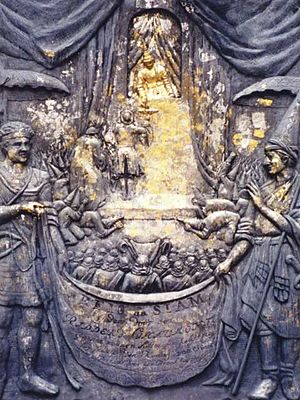
King Narai's policies inside his kingdom were often shaped by powerful foreign countries. These included China to the north, the Dutch East India Company to the south, and the English to the west. Narai tried to either stop their influence or create a balance of power among them.
In 1660, the Chinese invaded Burma. King Narai saw this as a chance to strengthen Ayutthaya's control over northern areas like Chiang Mai. He started a war with Burma from 1662 to 1664. His army successfully took control of Lampang and other cities.
Narai also gave control of the important port of Mergui to a French officer. He also gave the strategic port of Bangkok to the French. This was done to balance the strong influence of the Dutch.
King Narai also built a new palace in Lopburi. He used the skills of Jesuit architects and engineers from Europe. You can see European styles in the palace, especially the large windows. Moving to Lopburi was partly because the Dutch navy had blocked Ayutthaya in 1664. They wanted to control the fur trade.
Foreign Relations
King Narai's reign is famous for the many diplomatic missions he sent and received. He sent missions to faraway places like France, England, and the Vatican. He also kept strong ties with closer countries like Persia, India, and China.
The most well-known missions were those to Europe, especially France. In 1673, French church leaders arrived in Ayutthaya with letters from the Pope and King Louis XIV of France. King Narai sent his own mission to France in 1680. Although this mission was lost at sea, the French responded by sending a trade mission to Ayutthaya in 1682.
Growing French Influence
A controversial figure during Narai's reign was Constantine Phaulkon. He was a Greek adventurer who arrived in Ayutthaya in 1675. He quickly became a close advisor to King Narai. Phaulkon suggested rebuilding the fort of Mergui in a European style. He also encouraged King Narai to favor the French to balance the Dutch influence.
Phaulkon also made the French believe that King Narai might become Catholic. While Narai showed some interest in Catholicism, he also showed interest in Islam. There is no clear proof he wanted to convert to either. However, both Catholic and Islamic missions blamed Phaulkon for their lack of success. Many Siamese officials also disliked Phaulkon's influence. They felt he was too powerful and foreign.
Narai sent more Siamese missions to France. King Louis XIV of France then sent Chevalier de Chaumont as his main ambassador in 1685. This mission aimed to return the Siamese ambassadors and try to convert Narai to Catholicism. It included many Jesuit priests and scientists.
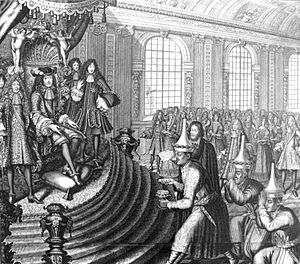
King Narai did not become Christian. However, he allowed French troops to be stationed in Siamese ports. Claude de Forbin became the commander of the Bangkok fort. He trained Siamese soldiers in Western fighting methods. Several Siamese forts were rebuilt in a European style.
Another Siamese mission went to France in 1686, led by Phra Visutsundhorn (Kosa Pan). This mission was very well received in Europe. A Siamese account of this trip, written by Kosa Pan, was found in Paris in the 1980s.
In 1686, a revolt happened in Ayutthaya. It was caused by the Makassar people who had sought safety in Siam. Constantine Phaulkon and Forbin helped defend the kingdom. The Makassars were defeated.
Samuel White, an English governor of Mergui fort, had a conflict with English ships from India in 1687. This led to an English blockade of Mergui. Some Siamese officials attacked local Englishmen. King Narai then had those officials removed to calm the English.
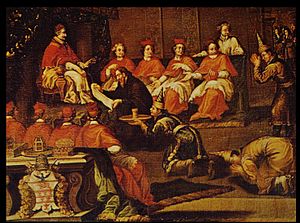
In 1687, a new French mission arrived in Ayutthaya. It included Kosa Pan returning home and General Desfarges with French soldiers. Narai agreed to have French troops at Mergui and Bangkok. Desfarges was stationed at Bangkok. The fort there is now called the Vijaiprasit Fort. The last Siamese embassy visited Rome and Pope Innocent XI in 1688.
The Change of Power in 1688
Throughout his rule, King Narai tried to reduce the power of local officials. He supported Persian and later French guards and advisors instead. The French gained special favors in religious and military matters. The building of French forts and military camps in Bangkok caused concern among the court nobles. Many felt that favoritism and unfairness were growing.
Phetracha, a commander of the Royal Elephants, became a leader for those who wanted to reduce foreign influence. Phetracha had family ties to Narai; his mother was the king's wet nurse, and his sister was one of the king's wives.
King Narai had adopted a son named Phra Pi and named him as his successor. The French supported Phra Pi and helped him become Catholic.
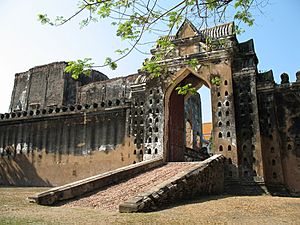
Things changed when King Narai became very ill in March 1688 at his palace in Lopburi. Knowing there would be a fight for the throne, Narai called his closest advisors in May 1688. These were Phaulkon, Phra Phetracha, and Phra Pi. He said his daughter, Kromluang Yothathep, should be his successor. The three advisors were to help her rule.
When Narai was very sick, Phetracha took action on May 18, 1688. He arrested King Narai, Phra Pi, and Narai's half-brothers. Phaulkon was also arrested and put in prison.
After questioning Phra Pi, it was found that he had planned with Phaulkon to take the throne. Phra Pi was removed from power on May 20. Phaulkon was also removed from power on June 5. King Narai, on his deathbed, could do nothing. Phetracha then removed Narai's half-brothers from power.
Phetracha ordered his troops to attack the French soldiers led by General Desfarges in Bangkok. When King Narai died on July 10 or 11, Phetracha declared himself the new king. After four months of fighting and talks, the French soldiers were allowed to return to France. Only the Dutch were allowed to trade in the capital for a while.
King Narai's Legacy
King Narai's reign saw the most foreign influence in the Ayutthayan court. His successor reversed many of his diplomatic achievements. Some historians wonder if this change made Ayutthaya weaker in the long run. However, limiting foreign influence might have also stopped Ayutthaya from being colonized. Because of his diplomatic successes, King Narai was later called "the Great." He is one of only seven Thai kings to receive this title.
The writings of foreign visitors during his reign are very valuable. They give us a rare look into the Ayutthayan court. Most original Ayutthaya records were destroyed when the city fell in 1767. These writings include accounts from French visitors like Chevalier de Chaumont and Father Tachard, and a Persian account.
During Narai's time, Thai literature also thrived. Poems praising King Prasat Thong (Narai's father) and King Narai himself were written.
Far away in France, two streets are named "Rue de Siam" in honor of Narai's missions. In Lop Buri Province, where Narai lived, a street was named "Rue de France" in 1985. This celebrated 300 years of relations between Thailand and France.
Two gifts from Siam to France had an unexpected impact. They were a pair of silver cannons. These cannons were stored in Paris. When rioting Parisians needed weapons on July 14, 1789, they found these cannons. They were the only ones that still worked and were used in the attack on the Bastille.
King Narai Hospital, the main hospital in Lopburi Province, is named after him.
See also
 In Spanish: Narai para niños
In Spanish: Narai para niños
- France-Thailand relations
- Constantine Phaulkon
- Claude de Forbin
- François-Timoléon de Choisy


